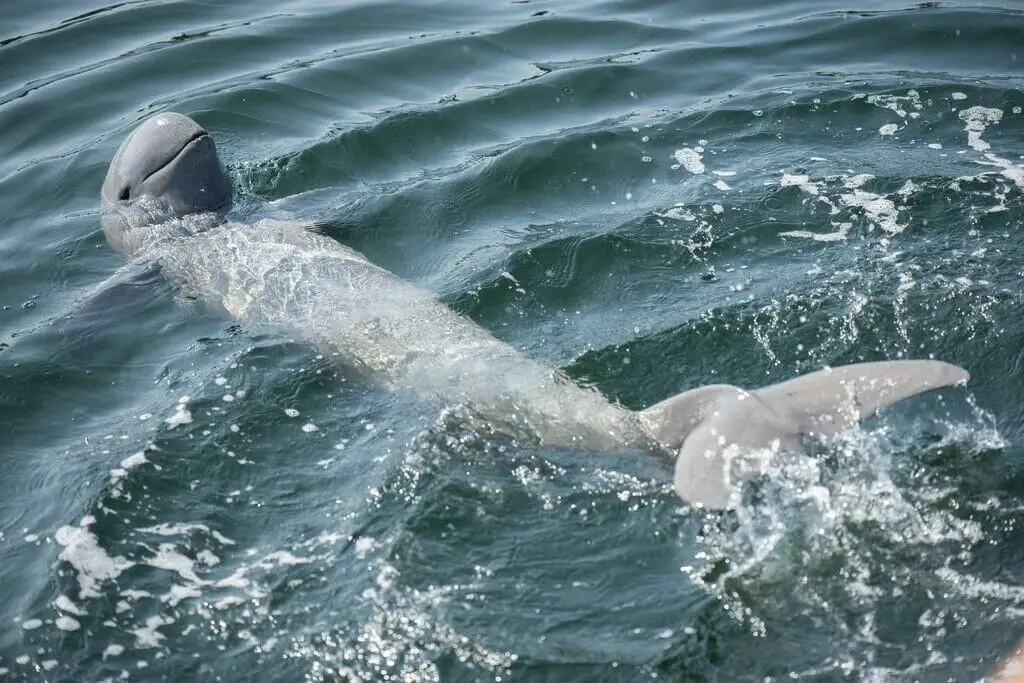The Mekong Wagtail and Irrawaddy dolphin are beautiful, gentle, elusive animals that – if you’re lucky – can be spotted in Southeast Asia!

If you’re planning a trip to Cambodia and are a lover of all things natural then we highly recommend organizing a trip to see these beautiful creatures with your own eyes.
Below, you’ll find out all you need to know about spotting these unique animals!
Where Can You See The Mekong Wagtail And Irrawaddy Dolphin?
Two of the best places to see these fascinating species are in Cambodia, particularly the Mekong mainstream at Kampi, and the lower Kong and San rivers just upstream of Stung Treng.
Passenger boats leave Phnom Penh for Kratie every day, and the crossing takes about five hours. You will also need to take a 30-minute moto-taxi ride upriver which will take you to Kampi, where many boats are available to rent.
Kampi is also the most popular and accessible place to view Irrawaddy Dolphins. Multiple pairs of wagtails make their home on the channel mosaic that stretches for 2-3 km upstream of the deep water pool believed by Irrawaddy dolphins in the dry season.
There are a minimum of three return flights between Phnom Penh and Stung Treng, where you can easily find a boat to rent.
You can either take a trip upstream a couple of kilometers where you can see many Mekong Wagtails, or you can journey downstream into the Mekong main channel and wonder at the mosaic habitat both up and downstream.
Another great place to spot Mekong Wagtails and Irrawaddy Dolphins is the Mekong main channel in southern Laos between Khon Falls and the Cambodian border.
What Is The Mekong Wagtail?
The Mekong Wagtail is a bird measuring 17 to 17.5 cm. The male Mekong Wagtail has a black forehead, a long, wide white supercilium, and a very slender white crescent under its eye.
They have black ear-coverts, lores, and necks, and a white triangular patch on their lower neck.
Meanwhile, female Mekong Wagtails are noticeably paler with a grey palette. Young Mekong Wagtails have a head pattern that is less distinct, a grey breast, and a dark malar stripe.
The Mekong Wagtail are often found in vast lowland river channels. They are territorial birds that make their homes along the fast-flowing parts of the river.
They breed on broad, lowland rivers when the riverbed is exposed to bushland and rocky outcrops and bushland. They tend to avoid wooded areas and commonly feed from bushes in the water. Unfortunately, their conservation status is near threatened.
What Is The Irrawaddy Dolphin?
Irrawaddy dolphins are oceanic dolphins that live in small groups throughout Southeast Asia where the seas are a mix of freshwater and saltwater.
What sets them apart from other dolphins is the fact that they have short, stubby noses and rounded heads. Some people believe they look like baby beluga whales, however, Irrawaddy dolphins are not closely related.
Because they have unique needs when it comes to their habitat, this means their habitat is limited. Their small groups also often come into contact with people! This has earned them serious cultural significance to a few communities in Southeast Asia.
Irrawaddy dolphins are found in coastal areas in South and Southeast Asia, and in some isolated freshwater bodies. They are mainly found in three major rivers.
These are the Mahakam River in Borneo, the Mekong River in Cambodia and Laos, and the Ayeyarwady River in Myanmar. They can also be found in the Songkhla Lake in Thailand and Chilka Lake in India.
While they do live in a 118-mile stretch of the Mekong River, sightings of them here are pretty rare.
Unfortunately, these dolphins are an endangered species due to climate change, entanglement in nets, reductions in their food source due to fishing, polluted water, and urbanization happening close to their homes.
Fun Irrawaddy Dolphin Facts

They Live In Unusual Habitats
Bodies of water contain different concentrations of salt known as salinities. Since Irrawaddy dolphins are euryhaline animals, this means that they are capable of living in waters with a wide variety of salinities.
They tend to live in areas where high-saline ocean water is combined with low-saline freshwater. As currents, ocean tides and other forces combine the freshwater and saltwater, the Irrawaddy dolphin is able to adjust to the various salinities.
They Are Only 1 Of 2 Species In Their Genus
They share a genus with the Australian snubfin dolphin, and in 2005 they were recognized as a separate species.
Their Rounded Heads Have Earned Them A Special Nickname
In Thai, Irrawaddy dolphins are known as loma hua bat (or the alms-bowl dolphin). This name refers to the shape of their head. An alms-bowl is a bowl used in religious ceremonies.
Irrawaddy Dolphins Are Related To Orcas
As well as the Australian snubfin dolphin, Irrawaddy dolphins are also closely related to orcas. They are both members of the Delphinidae family and are oceanic dolphins.
They Are Able To Herd Fish By Squirting Water
Irrawaddy dolphins can squirt water out of their mouths for a distance of over 1.5 meters. They do this so they can herd fish into smaller areas which makes them simpler to catch.
Irrawaddy Dolphins Can Spyhop
Irrawaddy dolphins engage in a behavior known as ‘spyhopping.’ This is when whales and dolphins pop their heads out of the water to study their surroundings for prey and predators.
They Help Out Fishermen
Irrawaddy dolphins have created a mutually beneficial relationship with humans, as they are known for driving fish into nets for fishermen. The dolphins are even rewarded with some of the catch!
Irrawaddy Dolphins Don’t Like Noise
Irrawaddy dolphins are sensitive creatures who are disturbed by noise pollution from things like boats. These noises cause them to head into deeper waters and stay away from heavily populated areas.
They Are Significant In Laotian and Cambodian Culture
There is a belief in Laotian and Cambodian cultures that Irrawaddy Dolphins are reincarnations of ancestors. Some people even believe that dolphins have rescued villagers from crocodile attacks and drowning.
Final Thoughts
We hope our article has inspired you to make a trip to Cambodia to see for yourself the Mekong Wagtail and Irrawaddy dolphin. Spotting these wonderful animals is definitely worth adding to your itinerary!









